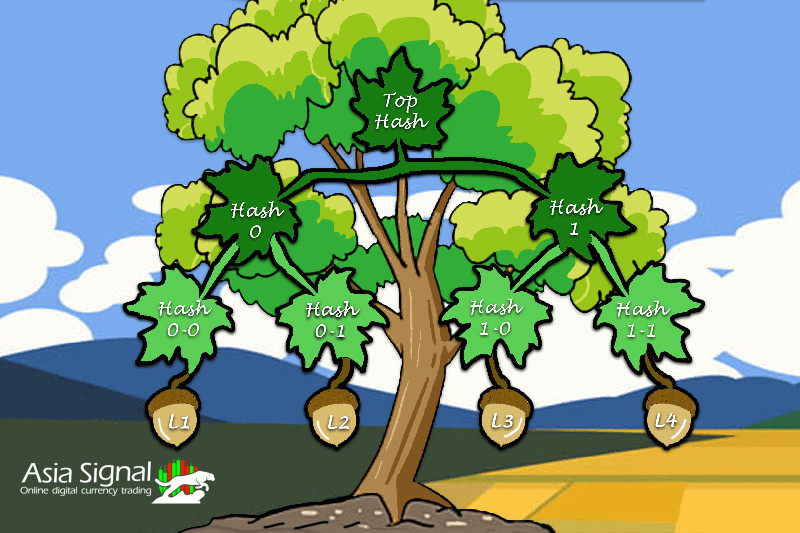Understanding the Merkle Tree: Building Trust and Efficiency in Data Structures
In the world of computer science and cryptography, the Merkle Tree, also known as the Hash Tree, is a fundamental concept that plays a crucial role in ensuring the integrity and efficiency of data structures. Named after the renowned computer scientist Ralph Merkle, the Merkle Tree has found numerous applications in various fields, including blockchain technology, data verification, and distributed systems. In this article, we will delve into the concept of the Merkle Tree, its construction, benefits, and applications.

What is a Merkle Tree?
A Merkle Tree is a hierarchical data structure that is built using cryptographic hash functions. It is designed to efficiently verify the integrity of large datasets and detect any modifications or corruption within the data. The tree's construction relies on the properties of hash functions, which produce a fixed-length, unique output (hash) for any given input data. Hash functions are collision-resistant, meaning it is computationally infeasible for two different sets of data to produce the same hash.
How Does a Merkle Tree Work?
A Merkle Tree is constructed by repeatedly hashing individual data blocks until a single root hash, known as the Merkle Root, is obtained. Here's a step-by-step explanation of how a Merkle Tree is built:
1. Data Segmentation: The data is divided into fixed-size blocks (usually binary), and if the last block is not a complete block, it may be padded to reach the desired size.
2. Hashing Leaf Nodes: Each data block is independently hashed using a cryptographic hash function (e.g., SHA-256). These hash values become the leaf nodes of the tree.
3. Pairwise Hashing and Combining: The leaf nodes are then paired together, and each pair is hashed again to produce a parent node. This process continues, pairing and hashing until only a single root hash (Merkle Root) remains.
4.Merkle Root: The final hash at the root represents the integrity and authentication of the entire dataset. Any change or corruption in the data will lead to a completely different root hash.
Benefits of Merkle Trees:
1.Data Integrity and Verification: Merkle Trees enable efficient verification of large datasets. By comparing the Merkle Root received with the computed Merkle Root, users can quickly detect whether the data has been tampered with or modified.
2. Efficiency: Merkle Trees allow for fast and secure verification without having to traverse the entire dataset. By using hash functions, even large datasets can be reduced to a single hash value, simplifying integrity checks.
3. Scalability: Merkle Trees can scale efficiently, making them suitable for applications in distributed systems and blockchain technology.
Applications of Merkle Trees
1. Blockchain Technology: In blockchain networks like Bitcoin and Ethereum, Merkle Trees are extensively used to validate transactions. Each block in the blockchain contains a Merkle Tree, which ensures that all transactions within the block are valid and unaltered.
2. Peer-to-Peer Networks: Merkle Trees are used in peer-to-peer networks for data synchronization and validation. They help in reducing the amount of data exchanged between peers while ensuring data integrity.
3. Version Control Systems: Merkle Trees are employed in version control systems like Git to efficiently detect changes and verify file integrity, making it easier to merge code changes and track modifications.
In conclusion, the Merkle Tree is a powerful data structure that provides a robust and efficient means of verifying data integrity and detecting alterations. Its applications extend across various fields, most notably in blockchain technology, where it plays a central role in ensuring the trust and security of decentralized systems. As the digital world continues to evolve, the Merkle Tree will remain a crucial tool in building trust and efficiency in data structures and cryptographic systems.
What is Merkle Root?
The Merkle Root, also known as the Root Hash, is a fundamental component of the Merkle Tree data structure. In the context of blockchain technology and cryptocurrencies, the Merkle Root is a cryptographic hash that represents the entire set of transactions included in a specific block of the blockchain.

How is the Merkle Root Calculated in a Blockchain?
In a blockchain, each block contains a collection of transactions that have been validated and grouped together. The Merkle Root is calculated by constructing a Merkle Tree from these transactions.
Here's how the Merkle Root is calculated:
1. Data Segmentation: All transactions in the block are organized into fixed-size blocks (usually binary) known as leaves. If the total number of transactions is odd, the last transaction is duplicated to create an even number of leaves.
2. Hashing Leaf Nodes: Each transaction (or leaf) is individually hashed using a cryptographic hash function, such as SHA-256. These hash values become the leaf nodes of the Merkle Tree.
3. Pairwise Hashing and Combining: The leaf nodes are then paired together, and each pair is hashed again to produce parent nodes. This process continues, pairing and hashing until only a single root hash (Merkle Root) remains. If there is an odd number of nodes at any level, the last node is duplicated to form a pair.
4. Merkle Root: The final hash at the root of the Merkle Tree is the Merkle Root. It represents the entire set of transactions in the block and serves as a compact representation of all the transactions' integrity.
Benefits of the Merkle Root in Blockchain
1. Efficient Verification: The Merkle Root allows for efficient verification of the integrity of transactions in a block. By comparing the Merkle Root in the block header with the computed Merkle Root, users can quickly determine if any transactions have been altered or tampered with.
2. Security: Since the Merkle Root is calculated using cryptographic hash functions, any modification to even a single transaction in the block will result in a completely different Merkle Root. This property ensures the immutability of the block's data.
3. Space Optimization: Storing the Merkle Root in the block header provides a compact representation of the transactions' integrity without needing to store all the individual transaction details
Use in Blockchain Consensus
The Merkle Root is an essential component of the block header in blockchain technology. It is included in the proof-of-work (PoW) or proof-of-stake (PoS) mining process as part of the consensus mechanism. Miners or validators use the Merkle Root, along with other block header data, to attempt to solve a cryptographic puzzle in PoW systems or participate in the block validation process in PoS systems.
In conclusion, the Merkle Root is a crucial cryptographic hash that represents the integrity of all transactions within a block in a blockchain. Its efficient verification and security properties make it an integral part of blockchain consensus and ensure the trustworthiness and immutability of the data recorded on the blockchain.

















Comments